As the servant of Akal Purakh Sahib, Bhagat Singh Bedi, grew spiritually and began to understand the depth of spiritual and mythological realms, he also began to research and create Hindu paintings. The diverse images of Gods and their stories, inspired Bhagat to paint them!
These paintings are inspired not only by texts such as the Puranas, Upanishads and Sutras but also by Bhagat’s Primary Guru, the Guru Granth Sahib. The Guru Granth Sahib contains many beautiful hymns of Vaishnav saints that often fill the artist with indescribable, uncontrollable and overflowing inspiration.
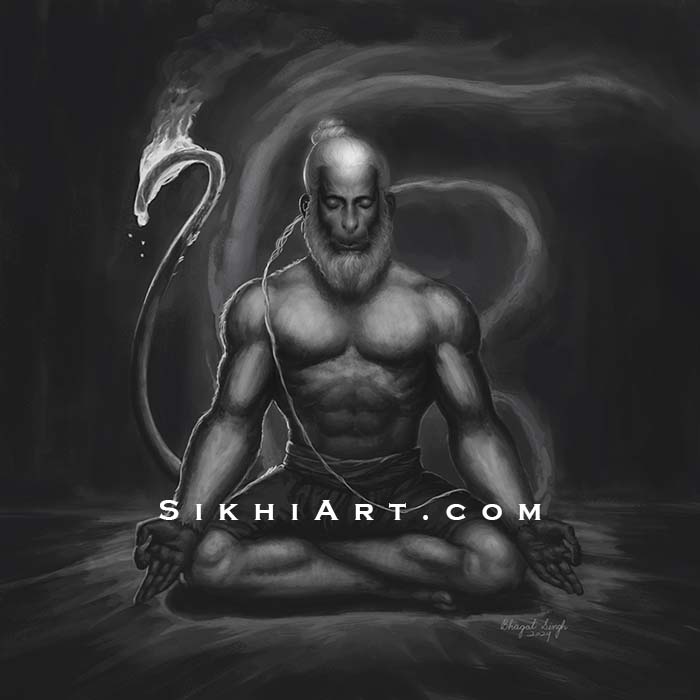
Hanuman ji Meditating on Shri Ram ji
Hanuman ji is an exalted Devotee of the Supreme God. He is strong, heroic and assertive, always ready to take action, as well as loving, calm and innocent, and immersed in states of pure love. He inspires us not only to do Meditation, bhakti, but also inspires us to be full of Energy, shakti, to exercise and to stay fit.
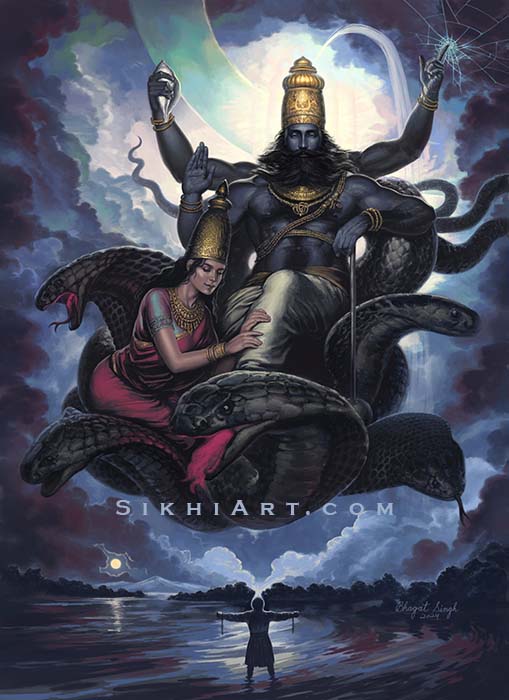
Shri Hari ji – The Source of Liberation
Bhagat paints a Symbol of that which underlies reality, in whom the world is perceived, that is within us and within others. His painting points towards our true nature, the understanding of which liberates us from our crippling beliefs and worldly bondages.
About the Prints
With your prints, you get colours as fresh and vibrant as Bhagat’s original paintings. They are so highly detailed that you will discover new details in the print every time you look to admire it. They will not fade or decay so you get a piece that you can treasure your whole life. On top of all that they bring strength, character and radiance into your home. Product Information »
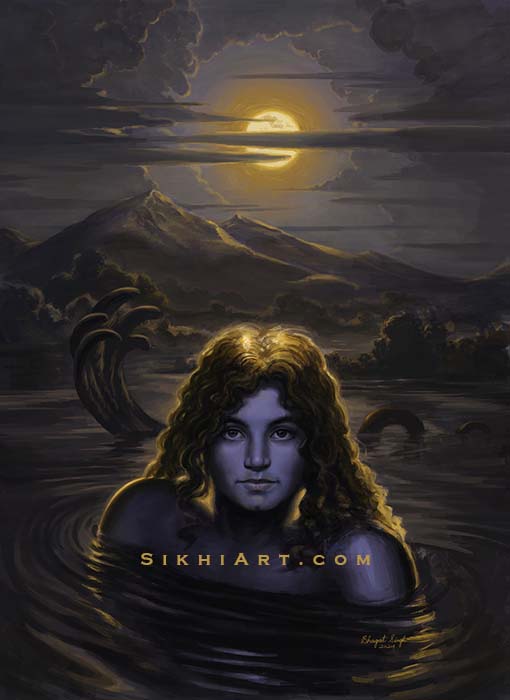
Shri Krishan ji – Banke Loin
Shri Krishan ji emerges from the Ocean of Grace to grace humanity with His Play.
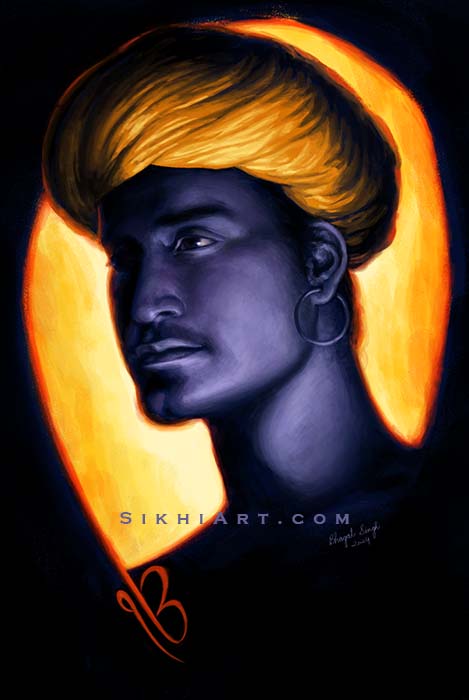
Shri Krishan ji – The Light Within
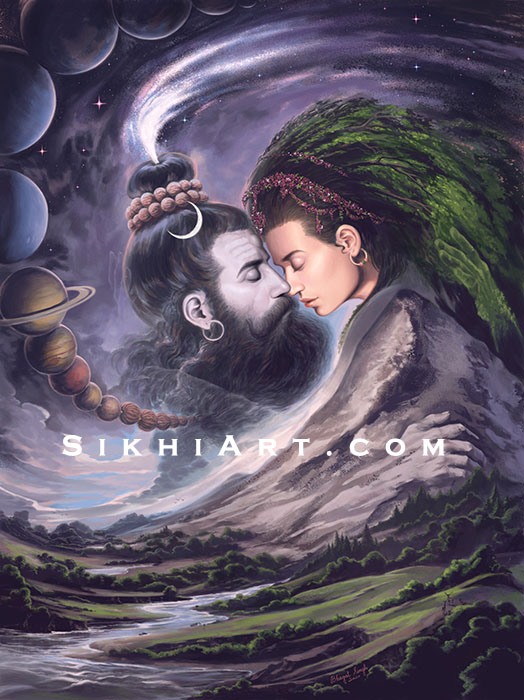
The Union of Shiva and Shakti
The Spiritual and Material Forces of the Universe, personified as Shiva and Shakti, embracing each other.
Never before in Hindu Art tradition or Sikh Art tradition has Shiv Shakti ever been portrayed in the way Bhagat has portrayed them. The artist has tasted this dimension within himself and has let it flow into his brushstrokes.
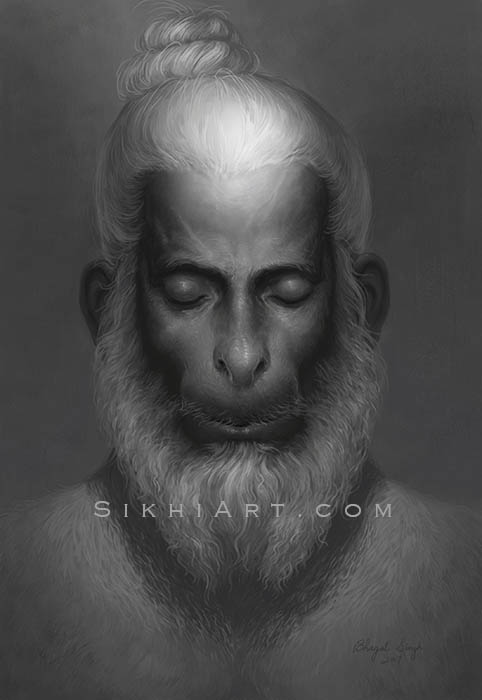
Hanuman ji Meditating on Shri Ram ji
Hanuman ji is an exalted Devotee of the Supreme God. He is strong, heroic and assertive, always ready to take action, as well as loving, calm and innocent, and immersed in states of pure love. He inspires us not only to do Meditation, bhakti, but also inspires us to be full of Energy, shakti, to exercise and to stay fit.
In Hindu Art tradition, the viewer can see Hanuman ji meditating, but in Bhagat’s painting the viewer can feel Hanuman ji’s meditation. This promotes a peaceful and blissful mind. Buy prints to inspire you to meditate on Raam Naam each and every day.
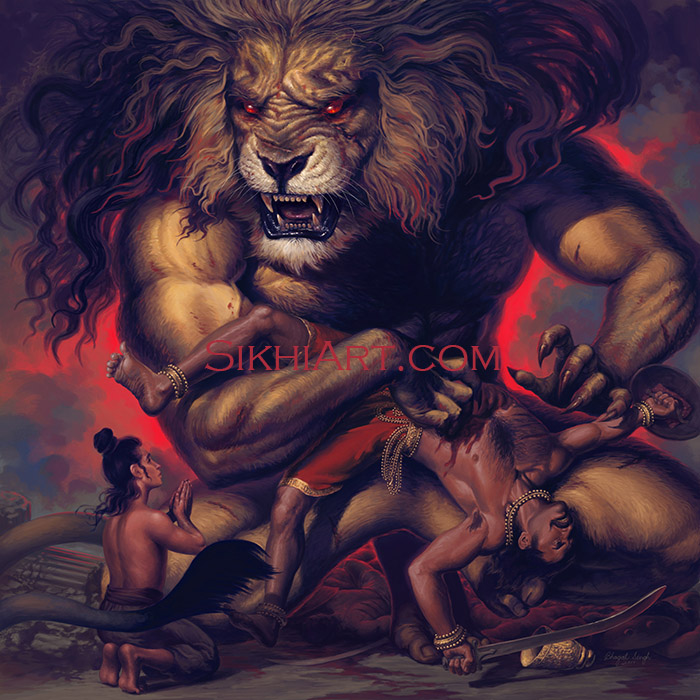
Narsingh ji Liberates Bhagat Prahlaad ji
Bhagat Prahlaad ji was still a child when he was brutally tortured to the brink of death. He had refused to give up his knowledge of God and his practice of meditating on him. In the end, Narsingh ji came to protect his devotee. After defeating Hiranyakaship’s army, Narsingh ji battled with Hiranyakaship and then ripped him apart with his claws.
Bhagat’s painting of Lord Narasimha portrays the Lord in pure epic-realism. Narsingh ji Narayan towers above His devotee while ripping apart Hiranyakashup in His arms. Buy prints of this epic moment to derive strength and courage from it. It inspires Bhakti bhawna within the viewer.
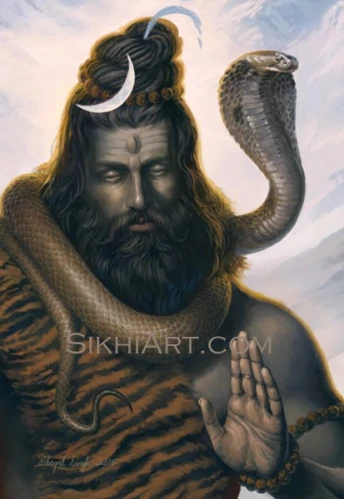
Sada Shiv ji
In Shaivism, Shiv ji is Mahadev, the Supreme God. He is Sada Shiv, ever-present, pure consciousness, the beginning and end of all things. He is the personification of great peace and great terror in different forms. Shiva is painted as the Adi Yogi, and he is bearded just like his bhakts, devotees, the yogis who meditate on him.
In Hindu Art tradition, Shiv ji is often depicted without a beard. However the artist Bhagat Singh wanted to highlight the devotees of Shiv ji, the Sadhus and Saints, who themselves keep their beard.
Sacred Art in the Making
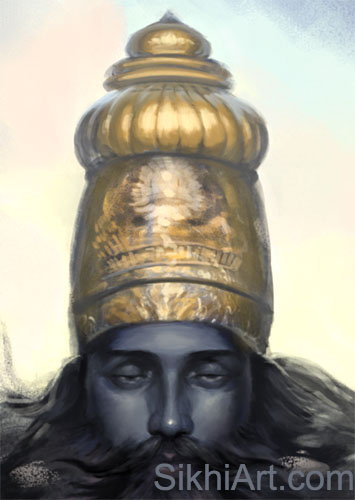
Hari Vishnu ji
In Vaishnavism, Vishnu ji is Akal Purakh, one who exists outside of time and space. He is Rama, residing everywhere, he is thousand-eyed without eyes and thousand-bodied without body, and with this leela/play he entrances everyone. Here, Vishnu ji is painted similar to Krishna, as the alpha male, the lover and caretaker of his soulmates. Being abundant, he is royally bearded, seated on his throne, with beautiful crown and jewellery.
Some Vaishnav religions have devotees who shave their head and their face, and they depict Vishnu ji without a beard in the vast world of the hindu art tradition. However Vishnu ji is known as Keshav. Many Vaishnav religions and Sikhism, take great inspiration from the Long-Haired Form of the Lord.
Bhagat’s painting of Lord Vishnu is greatly inspired by the Saints of these religions, showing the Supreme God in His Complete Form with all His Hair – Truly Keshav. In this way, artist Bhagat Singh leaves a unique mark in the hindu art tradition.
Divine Art Sketchbook
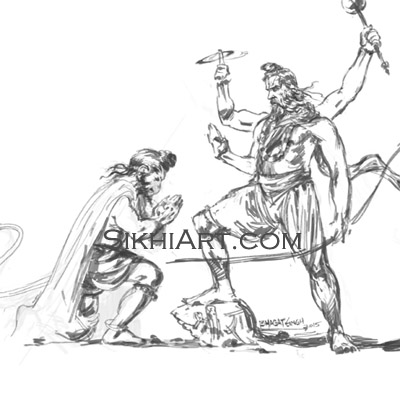
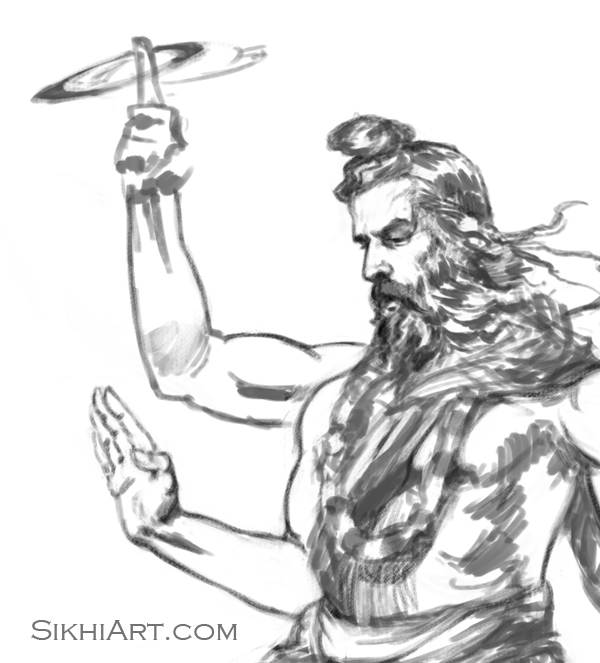
Shri Ram Chandra ji Blesses Hanuman ji
Even though he has no form or feature, Shri Ram is portrayed as the Chaturbhuj, four-armed Lord. He is seen holding a chakra and a mace. The chakra represents the wisdom and vision (su-darshan) that Ram is everywhere. The mace represents his rule over the universe, that everything happens by his command. In this sketch, he is blessing Hanuman ji and the stones and boulders, which were used to build a bridge to Lanka, Ravan’s kingdom.
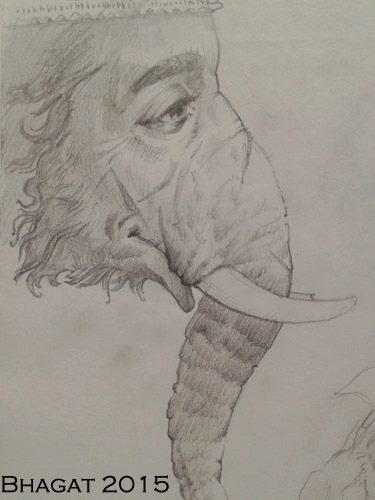
Ganesh ji
In Ganapatya religion, the supreme God is seen as the remover of obstacles, the prime mover. He is portrayed with the head of an elephant since elephants are big, powerful beasts, able to move large objects, and transport them.
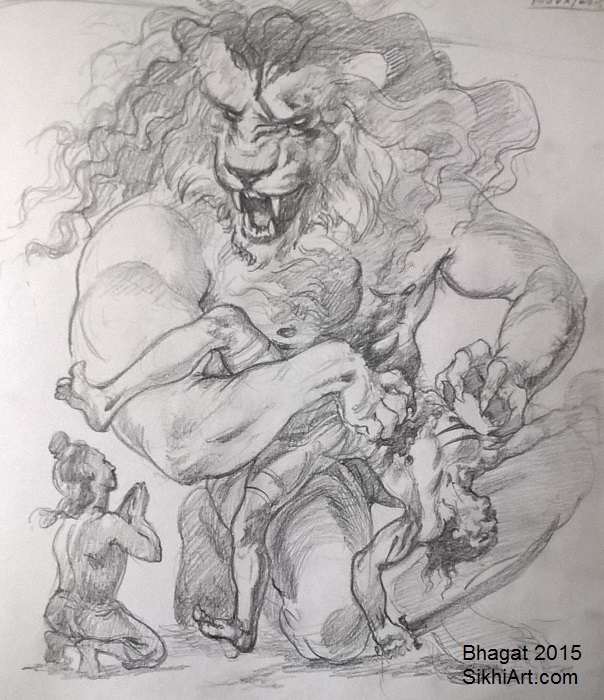
Narasimha Liberates Bhagat Prahalada
Ahankar (Ahan – I, Kar- Continous), the constant sense of self that sees itself as separate from everyone else, can neither be destroyed inside nor outside nor upside nor downside nor by man nor by animal nor by projectile nor by weapon nor by day nor by night. Ahankar can only be destroyed by Hari himself. In this sketch, the supreme being, Shri Hari takes the form of a Man-Lion to kill Harnakash, who is the respresentation of Ahankar, and liberates his devotee Prahlaad, who surrenders his self to him.
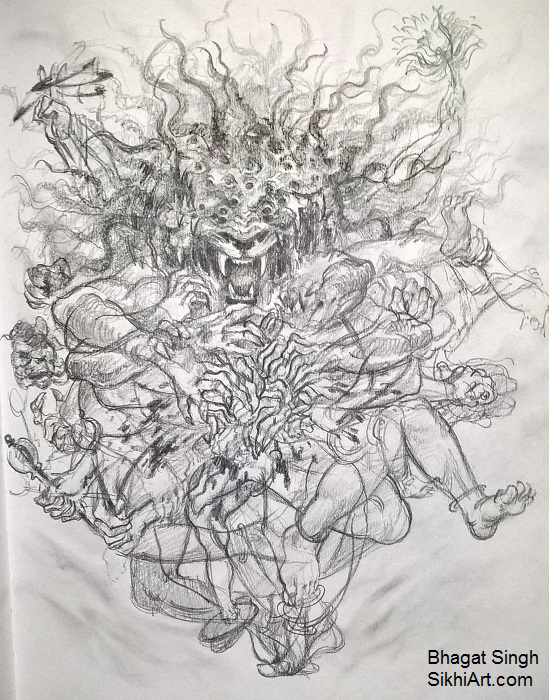
Narsingh Narayan
In Vaishnav religions, it is said that the supreme god, Narayan, who vibrates in the heart of all beings, assumed the form of a man-lion to destroy Hiranyakashup in order to save his devotee Prahlaad.
You have thousands of eyes and thousands of forms, however you are also without form as you are the source of all forms. You are the great giver, the source of sustenance of all beings.
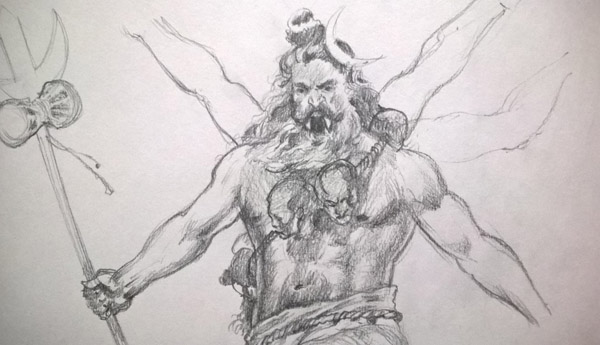
Mahakal
In Shaiv religions, Mahakal is the personification of supreme formless god, as the ultimate death. He is also known as Shri Kaal (meaning death) and Shri Kharag (meaning double-edged, straight sword).
The dumroo beats – dug dug dug dug – along with loud gongs, in his presence. A necklace of severed bloody heads glorifies his neck. The lustrous crescent moon in his top knot shines bright. His frighteningly large teeth drip with blood and his long red tongue vibrates as he roars a thunderous roar.
He is usually portrayed with four arms. However since I am not using any erasers for these sketches, I’ll probably transform that 5th arm into something else.
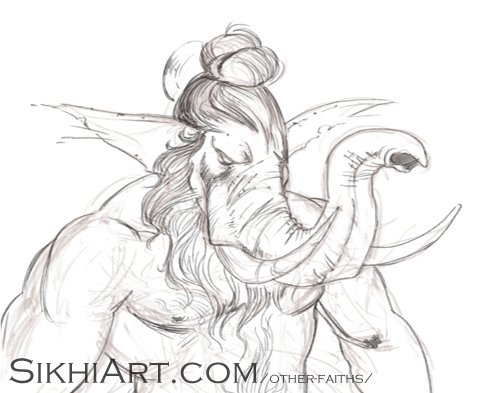
Ganesh ji
Here’s a quick sketch of Ganpati, which means – Ganesh, the father of all devotees. Unlike my previous sketches, I wanted to see what Ganesh ji would look like with a “topknot and beard”.
In the Ganapatya religions, the supreme God is seen as the remover of obstacles, the prime mover. He is portrayed with the head of an elephant with a trunk and tusks. Since elephants are big, powerful beasts, able to move large objects, and transport them, the elephant became a symbol, a representation for the characteristics of the Supreme Being and his qualities.
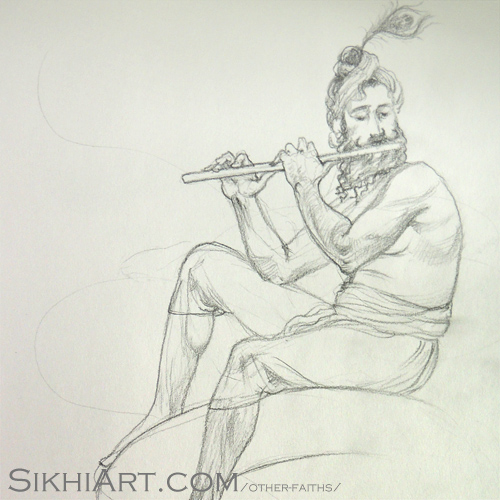
Krishan ji Playing Flute
In Vaishnav religions, the One Krishna is the God of Gods, he is the spirit inside of us. Our inner Atma is Shri Krishna and enlightenment comes from recognizing this secret, to see Krishna inside.
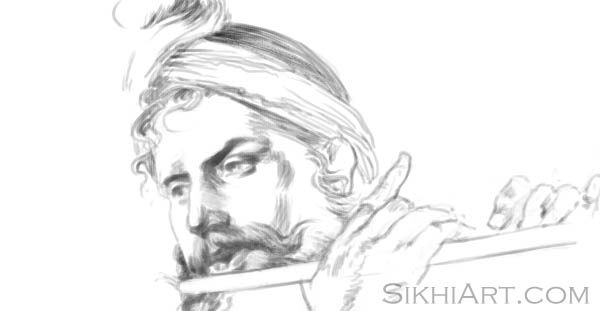
Krishan ji Playing Flute
I wanted to improve upon the previous sketch and draw Krishan ji again.
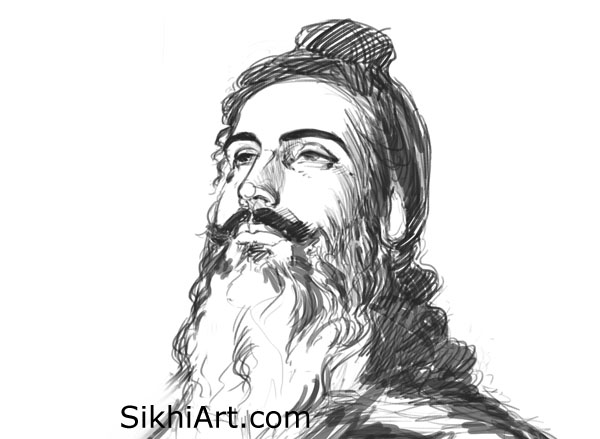
Lord Ram – Unshorn Hair
Nau Nidh Khatri asks, “Guru Gobind Singh Ji, the helper of poor, tell me, why have you kept Kesh, unshorn hair?”
Hearing this Guru Ji said, “You have studied many Shastra, many religious texts. You have spent your life listening and reciting the Shastra, yet you have not come to realize the answer”
Guru ji continued, “Adorning Kesh, long hair, is to keep this Dharam, this tradition alive, which was started by Sanak, Sanatan, Sanandan, Sanatkumar, and others. In the land of Bharat dwells a great country, here keeping Kesh, hair unshorn, is an important part of our Dharma.”
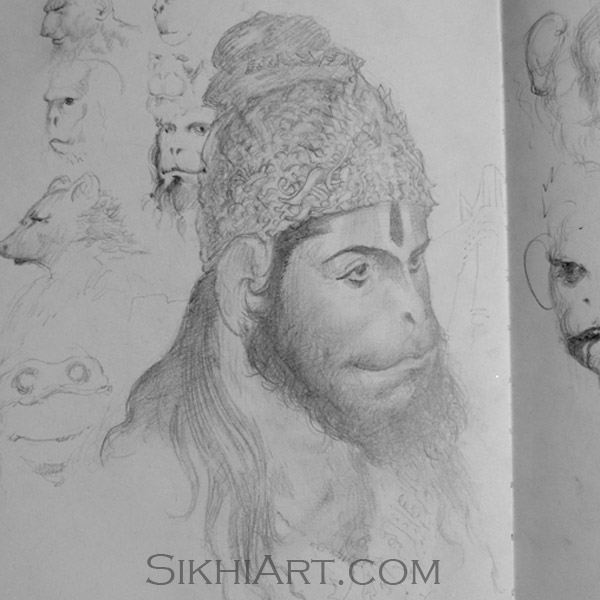
Hanuman ji Portrait
A page from my 2012 sketchbook. My father said that it was the most pleasing (pyari) drawing he’d ever seen of Hanuman ji. Last year, a couple months after my dad passed away, I started a painting from this sketch.
“You possess the essence of Ram; you always remain the servant of the Raghu King! Those who sing your praises obtain Ram; their suffering is eliminated in each birth! In the end, they enter the kingdom of Ram; and wherever they take birth they are known as the devotees of Hari!”
Ram rasayan tumhre pasa; sada raho Raghupati ke dasa. Tumhre bhajan Ram ko pavai; janm janm ke dukh bisravai. Ant kaal Raghupatipur jaie; jahan janm Hari bhakt kahaie.
Hanuman Chalisa, by Bhagat Tulsidas ji. Translation by Bhagat Singh.
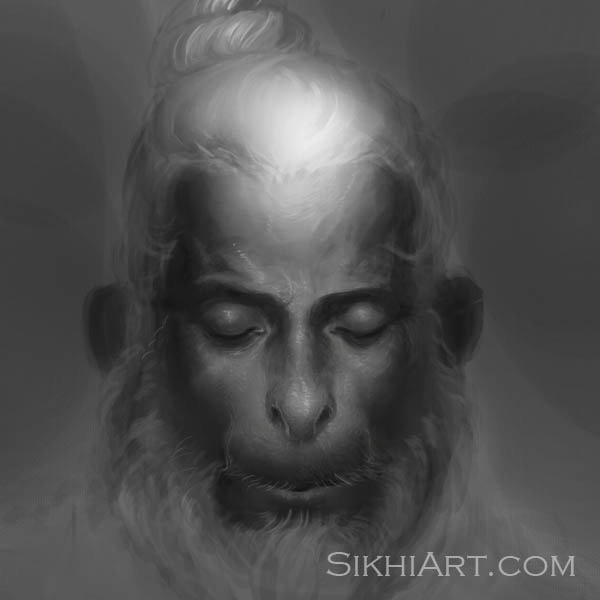
Hanuman Ji Meditating
This painting of Hanuman ji, from 2013, was inspired by the species of Indian monkeys named after him, known as ‘Hanuman Langur’.
Black skin gets a lot of bad rep in India, even though one of God’s epithets is “dark-skinned one”. So even though most people associate the image of Hanuman ji with ‘Rhesus Monkeys’, I thought it would be interesting to see Hanuman ji with the facial characteristics of the ‘Hanuman Langur’, with black-skin and white fur.
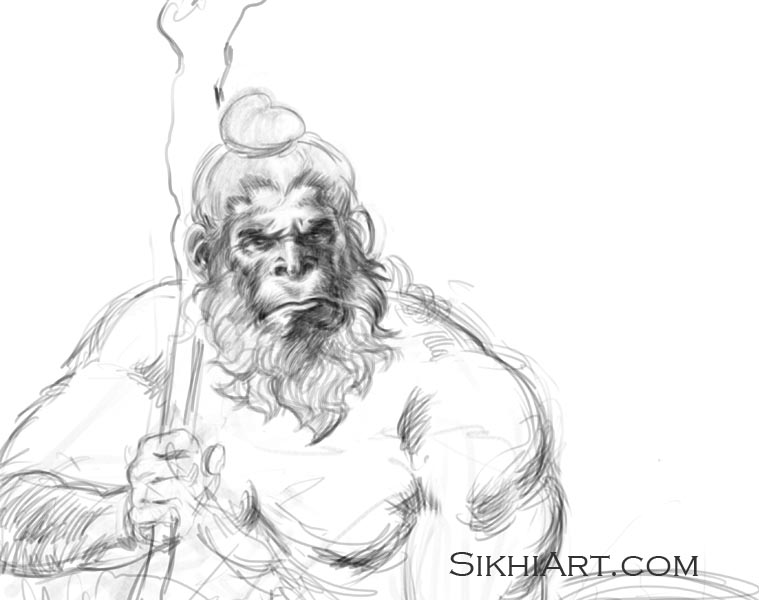
Hominid Hanuman ji
This is a recent sketch I did of Hanuman ji. This earthy version was inspired by early human species which are known as hominids (in Latin). This is why Hanuman ji is holding a wooden club in this sketch.
I imagined – what if Ram Chandra ji had encountered early hominids in the forests, who he then made an alliances with? What if hanuman ji was one of the last remaining early humans in India? if so what would he look like?
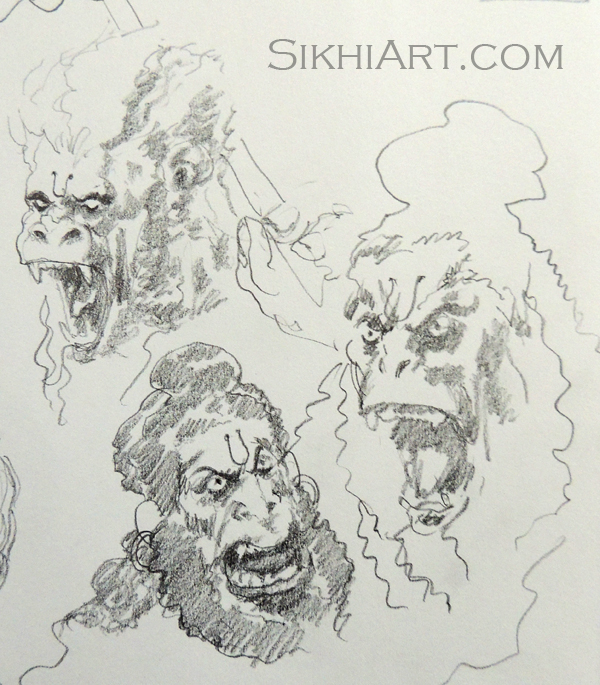
Furious Hanuman ji
Hanuman was furious! When surrounded by warriors, he planted his feet firmly on the ground, and defeated all of them! That is why he was known as Hanuman!
ਹਾਗੜਦੰਗ ਹਨੂ ਕਾਗੜਦੰਗ ਕੋਪਾ ॥ ਬਾਗੜਦੰਗ ਬੀਰਾਨ ਮੋ ਪਾਵ ਰੋਪਾ ॥ ਸਾਗੜਦੰਗ ਸੂਰੰ ਹਾਗੜਦੰਗ ਹਾਰੇ ॥ ਤਾਗੜਦੰਗ ਤੈਕੈ ਹਨੂ ਤਉ ਪੁਕਾਰੇ ॥੫੭੯॥
हागड़दंग हनू कागड़दंग कोपा ॥ बागड़दंग बीरान मो पाव रोपा ॥ सागड़दंग सूरं हागड़दंग हारे ॥ तागड़दंग तैकै हनू तउ पुकारे ॥५७९॥
– Ram Avtaar, Chaubis Avtaar by Kavi Shyam ji. Translation by Bhagat Singh
More to Come Soon!
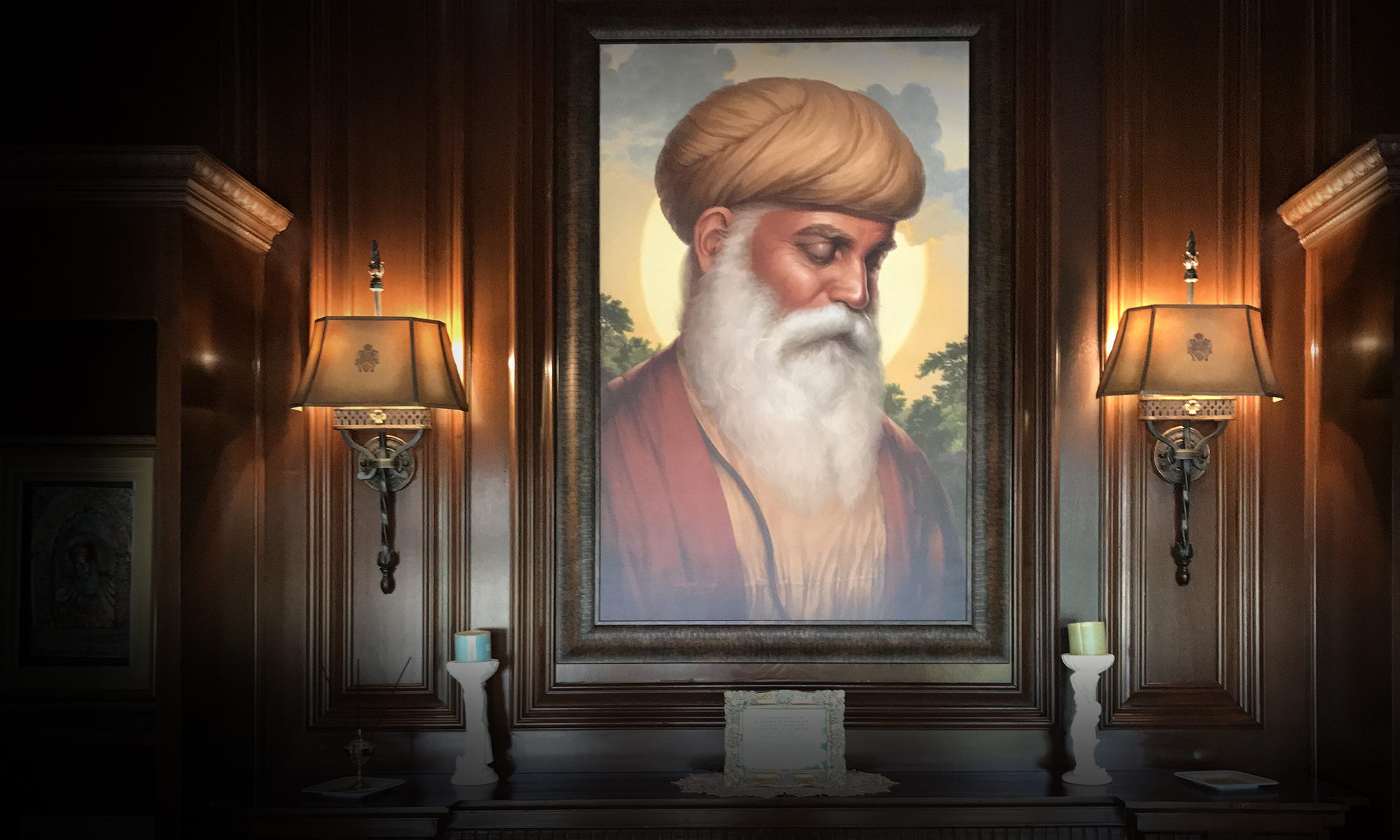

Very nice paintings. Naturally the Formless God must have looked like this during his avatars. Very natural ji!
Thanks Amit! These are representations of the Formless God in various Indian religions.
I have never seen such combination of painting and knowledge.
Your work is incredible. God bless you Brother…
Awesome paintings Bhagat ji. Opens doors to new Bhakti feelings after watching your pictures. You are really very gifted.
Do you have any plan on Buddhist art?
Nothing in the works. Let me know if you want to commission a Buddhist painting, I am open to it.
Hare krishnaa!!!!!!!! Beautifull paintings…. God bless you..plz make a painting of Radhe Krishna plzzz…..
In Dasam Granth. Guru Gobind Singh ji mentions that Ram Chandra had dreadlocks. Also why do you draw the joora in the front of the head. It should be right in the center of the head, in line with the ears, so much farther back, where samurais tie their top knot.
When hair isn’t oiled or untangled by hand or comb, then it becomes tangled and matted (clumped together). Shri Ram Chandra ji may have had matted hair at one point, we don’t know.
What we do know is that He did not have dreadlocks like rastafarians, for example, or certain groups of people who bind their hair into dreadlocks on purpose.
Is a joora supposed to be glued to the head, where it cannot move around?